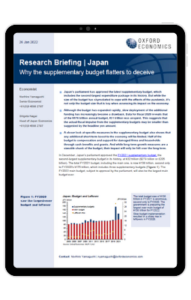Why Japan’s supplementary budget flatters to deceive

Japan’s parliament has approved the latest supplementary budget, which includes the second-largest expenditure package in its history. But while the size of the budget has skyrocketed to cope with the effects of the pandemic, it’s not only the budget size that is key when assessing its impact on the economy.
What you will learn:
- Although the budget has expanded rapidly, slow deployment of the additional funding has increasingly become a drawback. Data for fiscal 2020 reveals that of the ¥176 trillion annual budget, ¥31 trillion was unspent.
- A closer look at specific measures in the supplementary budget also shows that any additional short-term boost to the economy will be limited.
- Half of the budget is compensation and support for damaged firms and households through cash benefits and grants. And while long-term growth measures are a sizeable chunk of the budget, their impact will only be felt over the long term.
Tags:
Related Services

Post
House prices continue to slide for China’s cities
Research Briefing Why Japan’s supplementary budget flatters to deceive While the property market downturn has been universal, the scale and depth has been varied for different cities and regions.
Find Out More
Post
The Construction Productivity Challenge in Australia
Delve into the state of construction productivity in Australia. Understand the factors affecting growth and how innovation can transform the industry for the better.
Find Out More